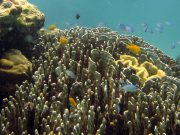Diving with Fire Corals & Hydroids
Lanta Marine Life | Hydrozoa
Fire corals and hydroids are a large group of solitary and colonial animals which have a complex life cycle which often involves an alternation between sessile (fixed in one place) polyp phase and a free-swimming medusa stage, similar to the True Jellyfish. Fire corals are a common sight when diving Koh Lanta.
In some groups of fire corals and hydroids, either the polyp or the medusa stage may be missing. Some families are able to produce calcium carbonate skeletons and form colonies, similar to the hard corals, however despite exhibiting very similar characteristics, these are not true corals.
They capture their prey and ward off enemies using stinging cells called nematocysts. Nematocysts are tiny cellular structures consisting of coiled, hollow and usually barbed, thread-like stingers, which usually contain poison.
The nematocysts are located throughout the tentacles that radiate either from the exterior in the sessile (stationary, fixed in one place) stage, or downward from the edge of the umbrella dome in the medusa (jellyfish) stage.
The reef building 'fire coral' family Milleporidae family can quickly grow large skeletons covered with many surface pores which contain stinging nematocysts.
Diving with Fire Corals & Hydroids around Koh Lanta
Scuba Diving & Snorkel Trips
If you'd love a chance to spot Fire Corals & Hydroids on one of our daily high season diving trips from Koh Lanta then send us an email to info@diveandrelax.com.
Join our high season speedboat dive trips to some of Thailand's best dive sites and enjoy small groups, short journey times, with a focus on great personal service, safety and fun.
Not yet a certified diver? Learn to Scuba Dive on Koh Lanta with the 3 day SSI Open Water Diver course.
Book online to save 10% on dive trips and scuba courses on Koh Lanta.
Find Out More
Indo-Pacific Marine Life Guides
- Allen, G., Steene, R., Humann, P., DeLoach, N. (2003) Reef Fish Identification, Tropical Pacific. Jacksonville, FL., USA: New World Publications, Inc., ISBN 1-878348-36-1.
- Humann, P., DeLoach, N., (2010) Reef Creature Identification, Tropical Pacific. Jacksonville, FL., USA: New World Publications Inc., ISBN 978-1-878348-44-9
- Debelius, H. (2013) Indian Ocean Reef Guide. Frankfurt, Germany: IKAN - Unterwasserarchiv, ISBN 978-3-939767-52-7.
- Debelius, H. (2004) Nudibranchs and Sea Snails, Indo-Pacific Field Guide. Frankfurt, Germany: IKAN - Unterwasserarchiv, ISBN 3-925919-51-1
- Erhardt, H., Knop, D. (2015) Corals Indo-Pacific Field Guide. Frankfurt, Germany: IKAN - Unterwasserarchiv, ISBN 3-925919-69-4.
- Veron J.E.N., Stafford-Smith M.G., Turak E. and DeVantier L.M. (2016). Corals of the World

